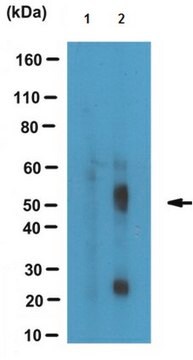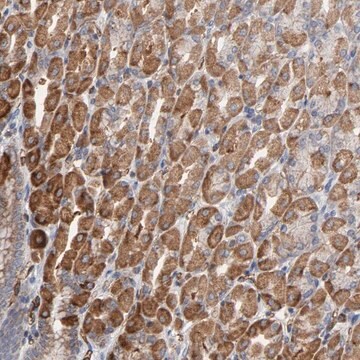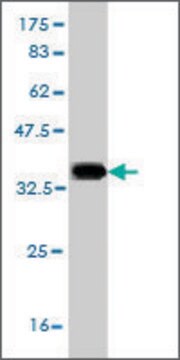推荐产品
一般說明
Betaine, (trimethylglycine) is an organic osmolyte that is available for cells by either choline oxidase-catalyzed synthesis or concentrative uptake by the betaine/GABA transport system (BGT-1). The intracellular accumulation of betaine protects cells from different kinds of stress including long-lasting dehydration, ischemia-reperfusion, and heat shock. Betaine has been considered a “chemical chaperone” because it prevents protein denaturation under adverse conditions, a property that likely contributes to the cytoprotective effects of this osmolyte.
Betaine--homocysteine S-methyltransferase 1, or betaine-homocysteine methyltransferase (BHMT) is the enzyme that is responsible for the metabolic elimination of betaine and homocysteine via their conversion to dimethylglycine and methionine. As such BHMT is one of a handful of key enzymes keenly responsible for betaine levels. BHMT is expressed at high levels in the human liver and kidney, localizing in the ER and cytoplasmic regions. BHMT expression is largely regulated at the level of the gene. BHMT activity becomes essential when folate-dependent remethylation is impaired because of nutritional deficiencies as it then provides the source for methionine. Deficiencies in BHMT can lead a variety of disorders ranging from vascular disease to neural tube birth defects such as spina bifida, fatty liver disease and cirrhosis all which can be linked to betaine metabolism disorders. EMD-Millipore’s Anti-BHMT mouse monoclonal antibody, clone 635, has been tested in western blots using recombinantly expressed BHMT cDNA and by immunohistochemistry on paraffin embedded human liver tissue samples.
Betaine--homocysteine S-methyltransferase 1, or betaine-homocysteine methyltransferase (BHMT) is the enzyme that is responsible for the metabolic elimination of betaine and homocysteine via their conversion to dimethylglycine and methionine. As such BHMT is one of a handful of key enzymes keenly responsible for betaine levels. BHMT is expressed at high levels in the human liver and kidney, localizing in the ER and cytoplasmic regions. BHMT expression is largely regulated at the level of the gene. BHMT activity becomes essential when folate-dependent remethylation is impaired because of nutritional deficiencies as it then provides the source for methionine. Deficiencies in BHMT can lead a variety of disorders ranging from vascular disease to neural tube birth defects such as spina bifida, fatty liver disease and cirrhosis all which can be linked to betaine metabolism disorders. EMD-Millipore’s Anti-BHMT mouse monoclonal antibody, clone 635, has been tested in western blots using recombinantly expressed BHMT cDNA and by immunohistochemistry on paraffin embedded human liver tissue samples.
免疫原
Purified recombinant fragment of BHMT expressed in E. coli.
應用
Anti-BHMT Antibody, clone 8C11H5 is a highly specific mouse monoclonal antibody, that targets Betaine--homocysteine S-methyltransferase 1 & has been tested in IHC & western blotting.
Immunohistochemistry Analysis: 1:500-1,000 dilution from a representative lot detected BHMT in human kidney and liver tissues.
Research Category
Neuroscience
Neuroscience
Research Sub Category
Developmental Neuroscience
Developmental Neuroscience
品質
Evaluated by Western Blotting in HepG2 cell lysate.
Western Blotting Analysis: A 1:500 dilution of this antibody detected BHMT in 10 µg of HepG2 cell lysate.
Western Blotting Analysis: A 1:500 dilution of this antibody detected BHMT in 10 µg of HepG2 cell lysate.
標靶描述
~50 kDa observed. Uncharacterized bands may appear in some lysate(s).
聯結
Replaces: MABE536
外觀
Unpurified
Mouse monoclonal IgG2b ascitic fluid containing up to 0.1% sodium azide.
儲存和穩定性
Stable for 1 year at -20°C from date of receipt.
Handling Recommendations: Upon receipt and prior to removing the cap, centrifuge the vial and gently mix the solution. Aliquot into microcentrifuge tubes and store at -20°C. Avoid repeated freeze/thaw cycles, which may damage IgG and affect product performance.
Handling Recommendations: Upon receipt and prior to removing the cap, centrifuge the vial and gently mix the solution. Aliquot into microcentrifuge tubes and store at -20°C. Avoid repeated freeze/thaw cycles, which may damage IgG and affect product performance.
分析報告
Control
HepG2 cell lysate
HepG2 cell lysate
免責聲明
Unless otherwise stated in our catalog or other company documentation accompanying the product(s), our products are intended for research use only and are not to be used for any other purpose, which includes but is not limited to, unauthorized commercial uses, in vitro diagnostic uses, ex vivo or in vivo therapeutic uses or any type of consumption or application to humans or animals.
未找到合适的产品?
试试我们的产品选型工具.
儲存類別代碼
12 - Non Combustible Liquids
水污染物質分類(WGK)
nwg
閃點(°F)
Not applicable
閃點(°C)
Not applicable
我们的科学家团队拥有各种研究领域经验,包括生命科学、材料科学、化学合成、色谱、分析及许多其他领域.
联系技术服务部门







